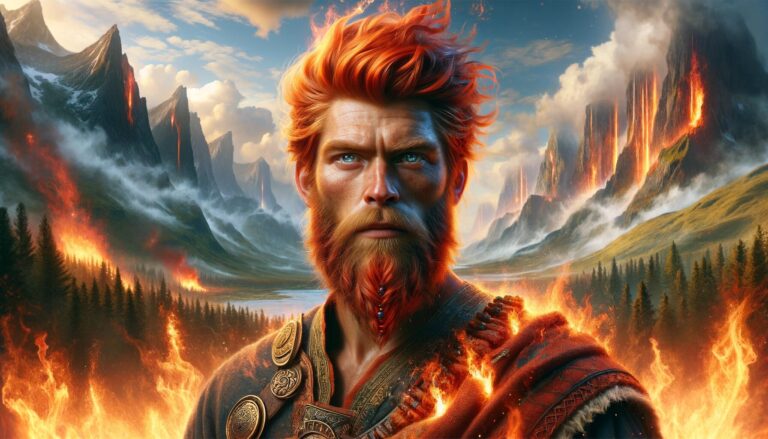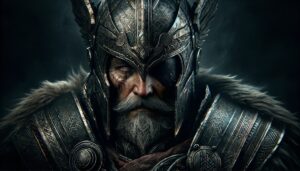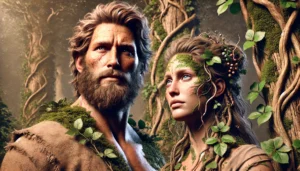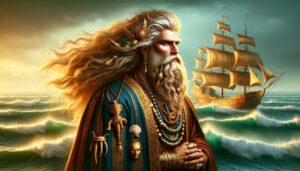Table of Contents
Loge, or Loki, a complex and multifaceted figure from Norse mythology, is renowned for his cunning and shape-shifting abilities. He is often portrayed as a trickster god with a penchant for mischief and a talent for causing chaos, yet he also plays a pivotal role in various myths, revealing his significant and varied influence on Norse tales.
Origin and Family Background
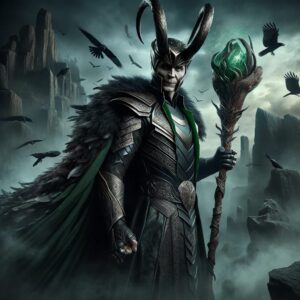
Loge, a central figure in Norse mythology, originates from the Norse pantheon. His parents, Farbauti and Laufey, are giants, a heritage that deeply influences his character and actions. This giant lineage imparts to Loge a unique blend of traits, distinguishing him from the Aesir gods. Consequently, his relationships within the pantheon are complex and multifaceted. Loge frequently aligns with the gods, yet he also stands as their adversary. His dual role as both ally and foe adds a rich layer of complexity to Norse myths. This duality reflects in the numerous tales where he shifts between helping and hindering the gods. Thus, Loge’s giant background and intricate relationships shape his unique position in Norse mythology.
Physical Appearance
In Norse mythology, Loge’s physical appearance is intriguingly fluid. Original myths do not consistently describe him, yet he is often portrayed as handsome and charismatic. His most striking feature is his shape-shifting ability. This power enables him to transform into various forms, ranging from animals to other gods. Loge frequently uses this shape-shifting to deceive others, showcasing his cunning nature. For instance, he transforms into a mare to lure away a giant’s stallion, a pivotal act in the mythology. In another tale, he becomes a salmon, evading capture by the gods. These transformations highlight Loge’s adaptability and resourcefulness. His ability to change appearance serves as a key tool in his trickster arsenal, making him a unique figure in Norse lore.
Behavioral Traits
Loge’s behavioral traits in Norse mythology are as dynamic as they are intriguing. He stands out for his cunning intelligence, a quality that defines many of his interactions. Additionally, Loge’s wit and eloquence are legendary, often giving him an edge in dealings with gods and mortals alike. He skillfully employs these traits to manipulate situations to his advantage. However, Loge’s character is not black and white. Despite his reputation as a trickster, he is not solely malevolent. His actions, complex and multifaceted, frequently benefit the gods as much as they create obstacles for them. This complexity adds depth to his character, making him more than just a simple antagonist in Norse mythology. In various myths, Loge’s actions showcase his ability to both aid and challenge the gods, reflecting his intricate role in the Norse pantheon.
Role in Norse Myths
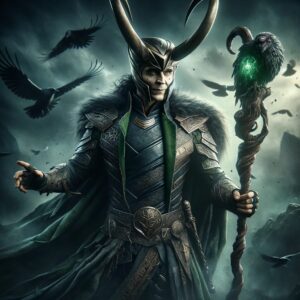
Loge’s role in Norse mythology is both fascinating and pivotal. He features prominently in a multitude of myths, often playing crucial roles that lead to varied outcomes. In the myth of Asgard’s walls, Loge employs deception to trick a giant builder, showcasing his cunning nature. This act not only protects the gods but also demonstrates Loge’s strategic thinking.
Loge’s Crack to Heaven
On one such occasion, Loge, known for his mischievous nature, opened a crack between heaven and the earth. This act, perhaps motivated by curiosity or a desire to cause trouble, had significant consequences. Through this crack, the giants, beings often at odds with the gods, were able to reach into heaven. They seized the opportunity to steal the apples of eternal life, which were grown in the heavenly orchard. These apples were of immense importance to the gods, as they were the source of their youth and vitality.
With the crack opened by Loge, a new element was introduced into heaven: Time. The eternal nature of the gods’ realm was disrupted, allowing Time to leave its mark on them. The gods, previously immune to aging, began to show signs of growing old, developing wrinkles and gray hair. This event was alarming and unprecedented, causing great distress among the gods.
Realizing the gravity of his actions, Loge apologized to the gods. His apology seemed sincere, and the gods, perhaps due to their inherent nature to forgive or their past experiences with Loge’s tricks, chose to believe him. They trusted that Loge would not commit such a reckless act again. However, given Loge’s complex and unpredictable nature, his future actions remained uncertain.
The construction of Asgard’s walls
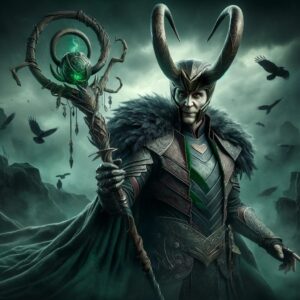
In Norse mythology, Loge’s involvement in the construction of Asgard’s walls stands as a notable tale. The gods agree to let a giant builder construct the walls with a promise of immense rewards, including the sun, the moon, and the goddess Freya, if he completes the task within a single winter. Loge suggests this risky deal to the gods, confident that the builder, with his horse, Svadilfari, cannot finish on time.
As the deadline approaches, the gods realize the builder might succeed, mainly due to the extraordinary strength of his horse. They blame Loge, demanding a solution. In response, Loge transforms into a mare, luring Svadilfari away and delaying the construction. The builder, revealed to be a mountain giant, fails to complete the walls on time and is denied his reward. Thor, angered by the giant’s attempt to outwit the gods, kills him.
Another famous story involves the theft of Thor’s hammer, Mjölnir. A giant named Thrym steals it, demanding Freya in exchange for its return. Loge, using his wit, devises a plan. He suggests dressing Thor as Freya to trick Thrym. Thor reluctantly agrees, and they travel to Jotunheim, the land of the giants. During the wedding feast, Thor, disguised as Freya, retrieves his hammer and unleashes his wrath upon Thrym and the other giants.
These tales highlight Loge’s dual nature in Norse mythology. In the first, he cleverly saves the gods from a dire situation but causes it in the first place. In the second, his cunning directly aids the gods, showcasing his capacity to be both a problem and a solution in the mythic narratives.
Ragnarok
In Norse mythology, the cataclysmic event known as Ragnarok marks the end of the world, characterized by a series of apocalyptic battles and natural disasters. Loge plays a central role in this myth, leading a host of forces against the gods, signaling his final break from the Aesir.
Loge’s forces are a formidable assembly of various beings. He leads the giants, his kin from his father’s side, aligning with the enemies of the gods. Alongside the giants are Loge’s monstrous children: the wolf Fenrir, who breaks free from his chains; and Jörmungandr, the Midgard Serpent, rising from the seas. These beings represent the chaos and destruction that Loge brings to the battlefield.
During Ragnarok, Loge confronts Heimdall, the watchman of the gods. Their battle is one of the many prophesied duels that take place during Ragnarok. Loge and Heimdall are destined to kill each other, a testament to the deep enmity and complex relationships Loge shares with the gods.
Ragnarok culminates in the death of many gods, including Odin and Thor, and leads to the submergence of the world in water. After these events, it is said that the world will resurface anew, fertile and reborn. Loge’s role in Ragnarok, leading the forces against the gods, highlights his transition from a mischievous trickster to a harbinger of destruction and change. This myth underscores the intricate tapestry of Norse mythology, where gods and beings like Loge play multifaceted roles that intertwine fate, loyalty, and vengeance.
Symbol
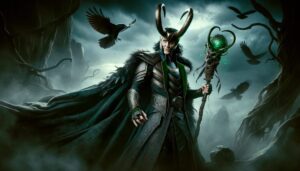
The snake symbol, commonly associated with Loge in Norse mythology, ties closely to one of his most famous punishments. This punishment stems from Loge’s involvement in the death of Baldr, one of the most beloved gods. Loge, known for his trickery, deceives Höðr, the blind god, into killing Baldr with a mistletoe-tipped arrow, the only thing capable of harming him.
The gods, outraged by this treachery, capture Loge and devise a severe punishment. They bind him beneath a serpent positioned above his head. This serpent continually drips venom onto Loge’s face. In response, Loge’s loyal wife, Sigyn, stays by his side, holding a bowl to catch the venom. However, whenever she leaves to empty the bowl, the venom falls on Loge, causing him immense pain. This leads to convulsions that are said to cause earthquakes.
Wife and Progeny
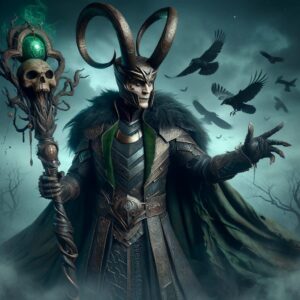
In Norse mythology, Sigyn, Loge’s wife, is celebrated for her unwavering loyalty and devotion. Her dedication becomes most evident during Loge’s punishment for his role in Baldr’s death. As Loge suffers, bound beneath a venom-dripping serpent, Sigyn remains by his side. She tirelessly holds a bowl to catch the venom, alleviating his pain, a testament to her steadfast love and loyalty.
Loge’s offspring also play crucial roles in the Norse mythological landscape. Fenrir, the fearsome wolf, is one of Loge’s children. Destined to grow to a tremendous size and strength, Fenrir becomes a source of concern for the gods. They bind him with chains, only for him to break free during Ragnarok, where he fulfills the prophecy of devouring Odin.
Jörmungandr, the Midgard Serpent, another of Loge’s children, encircles the earth, holding its tail in its mouth. This serpent plays a pivotal role in the cosmic balance and is destined to fight Thor during Ragnarok. Their battle, foretold in the myths, ends with the death of both adversaries.
Lastly, Hel, Loge’s daughter, rules over the eponymous realm of the dead, Helheim. Half-dead and half-alive in appearance, she governs those who die of illness or old age. Her realm is distinct from Valhalla, where warriors slain in battle go. Hel’s role in Norse mythology emphasizes the diverse destinies awaiting the dead, contributing to the complex tapestry of the afterlife concepts in these ancient narratives.
Together, Sigyn’s devotion and Loge’s children’s significant roles deeply enrich the intricate world of Norse mythology, showcasing the diverse and profound impacts of Loge’s lineage.
Other Names
Loge is known by various names across different sources, including Loke, Loder, Lokkju, and Lopter, reflecting the different aspects of his character and the varied traditions in Norse mythology.
Loge’s multifaceted nature makes him one of the most intriguing figures in Norse mythology, embodying the complexities of the human condition through his actions and stories. His role as a trickster, combined with his deep connection to significant events in the myths, underscores his importance in the Norse mythological tradition.
FAQ
What does Loge look like?
Loge's appearance varies, but he is often depicted as a handsome and shapeshifting figure with fiery red hair.
What are Loge's powers?
Loge possesses the ability to change his shape and create illusions. He's known for his cleverness and wit, using them to deceive and cause trouble.
Is Loge a friend or foe of the other Norse gods?
Loge is considered a complicated character. He can be both a friend and a foe to the Norse gods, as his actions can be unpredictable.
What are some famous stories involving Loge?
Loge plays a central role in many Norse myths, including the story of the theft of Thor's hammer and the binding of the wolf Fenrir. His tricks and actions often lead to significant events in Norse mythology.
Are there any symbols associated with Loge?
Fire and flames are often associated with Loge, symbolizing his connection to chaos and destruction.
What is Loge's role in Ragnarök?
In Norse mythology, Loge is said to be involved in the events leading up to Ragnarök, the end of the world, where he fights alongside the forces of chaos against the gods.
Does Loge have any family members?
Loge is the son of the giant Farbauti and the giantess Laufey. He is also the blood brother of Odin, the chief of the Norse gods.
Is Loge worshiped today?
Loge is not commonly worshiped in modern times, but he remains a prominent figure in Norse mythology and popular culture.
